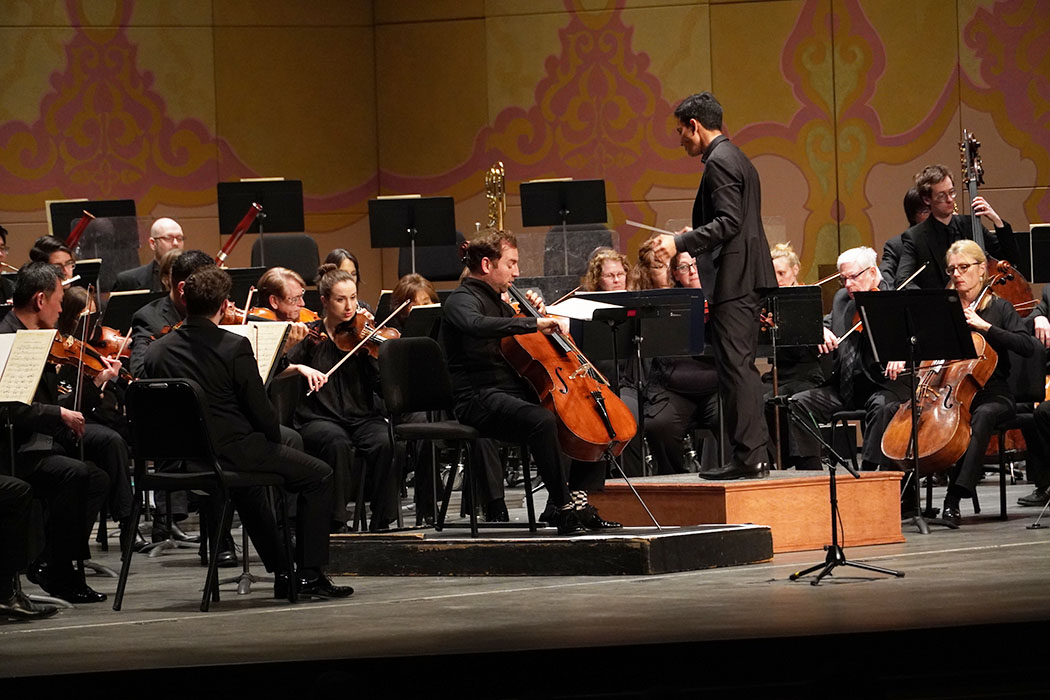The month of March has had the intriguing distinction, as far as the Knoxville Symphony Orchestra is concerned, of being both Cello Month and Guest Conductor Month. That intersection began with the earlier Chamber Classics Series which enjoyed an impressive appearance by guest conductor Michelle di Russo leading the Chamber Orchestra in a program that included Vivaldi’s Concerto for Two Cellos in G minor. That concerto was handled magnificently by two KSO cellists, Sarah Senn and Adam Ayers.

For this weekend’s Masterworks concerts, guest conductor Vinay Parameswaran had the podium for a program in which Dvořák’s Symphony No. 8 and a work by the young composer Quinn Mason bookended two works for cello and orchestra. Cellist Tommy Mesa was on hand for Dvořák’s hauntingly beautiful Silent Woods (Waldesruhe) and Tchaikovsky’s Variations on a Rococo Theme, Op. 33.
Mesa, a much-heralded and awarded young Cuban-American cellist, found both the forest and the trees in Silent Woods, painting his sound with thoughtfully considered details rather than long, unbroken brushstrokes. Something of the opposite seemed to be true in the Tchaikovsky Rococo Variations, where Mesa treated the individual variations as specific characters and sought to illuminate the idiosyncrasies of each with intriguing tone and technique. And, following the seventh variation, when one’s lyrical attention begins to drift amid a strange orchestral sameness of texture, Mesa stoked the fire for a heart-stopping Coda that is Tchaikovsky at his most exciting—one that spiritedly yanks the audience out of whatever reverie they had settled into. In both works, Mesa made it clear that both marvelous technique and captivating interpretation are a part of his musical storytelling ability.

It’s worth a reminder that KSO concertgoers are indeed a lucky bunch to have two downtown concert halls with excellent acoustic environments: the intimate acoustic clarity of the Bijou Theatre and the warm resonance of the Tennessee Theatre with its marvelously supportive orchestra shell. Of the latter, this point was brought home with the superb performance of Dvořák’s Symphony No. 8 by Parameswaran and the orchestra. Full acoustic advantage was taken for a grand work that is often referred to as “Beethoven-like” in its sweeping scale and “Tchaikovsky-like” in its textural details, with both qualities modulated by an inherent Czech folksiness.
As an example, the opening theme taken by the cellos was warm and well-articulated, appropriately and subtilely balanced with the horns as they enter. In general, Parameswaran managed perfectly the controlled complexity of the Allegro con brio with its changes of character. The sweeping character of the slow Adagio movement drew one into a place of quiet drama, which unfortunately was broken by a few audience members who insisted on applauding at the end, apparently oblivious to the shattering of emotional impact for everyone else. The third movement’s familiar waltz-like grandeur promoted by the strings was punctuated by glorious melodies and textures from the woodwinds, perfectly projected. Parameswaran parceled out the tempo changes in the closing Allegro ma non troppo, allowing them to build quiet tension into undeniable joy that figuratively explodes with brassy exuberant finality at the end.
Parameswaran opened the evening with A Joyous Trilogy by the 27-year old composer, Quinn Mason. This through-composed work in three movements—I. Running, II. Reflection, III. Renewal—is a veritable blur, or perhaps more accurately, a smorgasbord, of vibrant orchestral textures that glisten and glitter, running the gamut from metaphorical daybreak to midnight. Of particular note, the substantial trombone passage was beautifully played by KSO Principal Trombone, Samuel Chen.








As a member of the KSO, I have to say the applause between the movements provided quite the opposite effect. A tangible sign of appreciation and involvement actually feeds our energy to deliver an even more impactful performance. Whenever this happens, I know the audience is right there with us on the journey and it provides accessibility to the music. What a treat it is to garner that kind of excitement!
With respect to your appreciation of an “uninterrupted” symphony, I have to say that hearing applause between movements is definitely acknowledged and cherished. As a musician of the KSO I feel the impact the music has upon the room of listeners in a way only a live performance can deliver. The funereal, ethereal, and Mercurial charm of the second movement of the Dvořák is a beautiful example of many of the composers finest expressive qualities. If an audience is moved to applaud, I observe it as a tender esteem rather than a blemish.